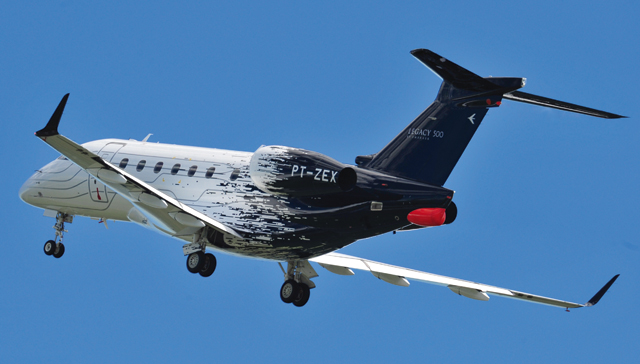Cessna enthusiastically launched what was then described as the “light-midsized” Latitude programme three years ago, but was really playing catch-up. Rival Embraer had already stolen a scheduling lead in 2008 by unveiling the Legacy 500 and 450 jets. The Brazilian airframer had targeted the broad middle of the business jet market with an ambitious suite of new features, including fly-by-wire controls and a flat-floored stand-up cabin.

Embraer
For Cessna, it must have seemed like a reply. Embraer had already intruded on the Wichita, Kansas-based manufacturer’s turf before with the entry-level and light Phenom 100- and 300-series jets, but the Legacy 500 and 450 aimed to topple Cessna’s Citation standard-bearers – the super-light XLS and midsized Sovereign.
Rather than reach for a clean sheet of paper, Cessna took a calculated gamble and decided it had many of the necessary pieces already in place to stay competitive. The fuselage and wings of the XLS and Sovereign would be retained, but each would receive uprated engines and a major avionics refresh with the new Intrinzic flightdeck, which is powered by the Garmin G5000 touch-controlled system.
These re-branded “+” models of two of Cessna’s most popular brands would be trusted to bracket the new competitors, but something else would be needed to meet the challenge posed by the Legacy 450.
Innovative products have a way of overthrowing preset categories, and the Legacy 450 is a prime example. By offering a jet with the cabin length of the XLS but with about 800nm more range, the Legacy 450 defies being neatly categorised. Cessna knew it would need to come up with something between the XLS+ and Sovereign+ to stay in the game.
The result is the Latitude and a careful application of matured and new technology. Having already proven the new Intrinzic flightdeck on the XLS+ and Sovereign+, Cessna could simply port the Garmin G5000 over to the Latitude. The Pratt & Whitney Canada PW306D turbofan engine developed for the Sovereign+ was also now on the shelf for the Latitude, as were the wings and aft fuselage of the Sovereign.
The area where Cessna could not afford to miss a step, however, was in the cabin. The Legacy 500 and 450 jets introduced a 1.83m (6ft)-tall cabin with a flat floor, and Cessna’s response would have to encompass a new fuselage design.
Now making its debut on static display at the NBAA convention, the second Latitude prototype (internally designated “P1”) reveals how far Cessna has pushed the company’s own boundaries inside the cabin, says Chris Hearne, Cessna’s vice-president for jet programmes. The full production interior reveals a cabin with a feeling of width and height more commonly associated with a super-midsize jet, but packaged with a length slightly shorter than found on the Sovereign in the midsize category.
Given an expanded volume, the Latitude’s designers set about reinventing how Cessna crafts an interior experience, Hearne says. The sense of space is enhanced by 10 cabin windows, which are 30% larger than the transparencies of any previous Cessna model, he adds.
The Latitude pairs this with a new level of environmental comfort. An automated air management system pioneered on the Sovereign+ is installed on the Latitude, maintaining a 6,000ft atmosphere within the cabin, following a trend established by the Boeing 787 and Gulfstream G650.
Access to the cabin is a new electrically-powered airstair, the first of its kind in Cessna’s product inventory, Hearne says. As you enter the cabin, the door is opposite a well-stocked refreshment centre, including a hot beverage tank and storage cabinets.
Turning right into the cabin, there are eight seats, including a two-seat divan, four seats in an executive club layout and two forward-facing seats. Lacking a recessed centre aisle, the cabin is lit by LED lamps under each seat. An optional upgrade allows some owners to light roughly 5cm (2in) reveals surrounding the windows with a multi-hued LED system, Hearne says.
The rear door of the cabin opens into the lavatory with a belted, side-facing seat, raising the total number of possible passengers to nine. The six club chairs in the cabin were developed for the Sovereign+.
The new interior design is complimented by a modern approach to cabin management and entertainment. The prototype model on display features a bulkhead-mounted monitor, but the feature is redundant. All of the cabin features – the lighting, audio and entertainment – are controlled wirelessly by the Clarity system, which allows passengers to adjust the controls using an application from their smartphone and tablet. If the pilot agrees, the VIP passenger has the authority to control cabin temperature from a personal mobile device.
“That’s what the customer is saying,” Hearne says. “‘We don’t need monitors anymore, just go ahead and provide me the means to use my smartphone or tablet.’”
The $16.2 million Latitude is an example of the careful application of new technology. Cessna is the established leader in the light and midsize jet segments. It is betting on that brand and a refined cabin experience to remain the market leader, despite the encroachment of a new, well-financed competitor with advanced technology.
One sign pointing in Cessna’s favour is the Latitude programme’s orderly march through the development phase. With more than two-thirds of the flight test complete as of late September and all four test vehicles in flight status, the Latitude appears on track to hit its original delivery milestone in the second quarter of 2015.
As the recipient of so many technologies matured on prior programmes, the US Federal Aviation Administration has agreed to allow Cessna to forego functional and reliability testing for the Latitude, a major concession that recognises the built-in maturity of the Latitude’s technology.
“We are continuing to hit every programme milestone and we are on schedule for entry into service in the second quarter of 2015,” says Hearne.
Get all the latest coverage from NBAA here
Source: Flight Daily News



















